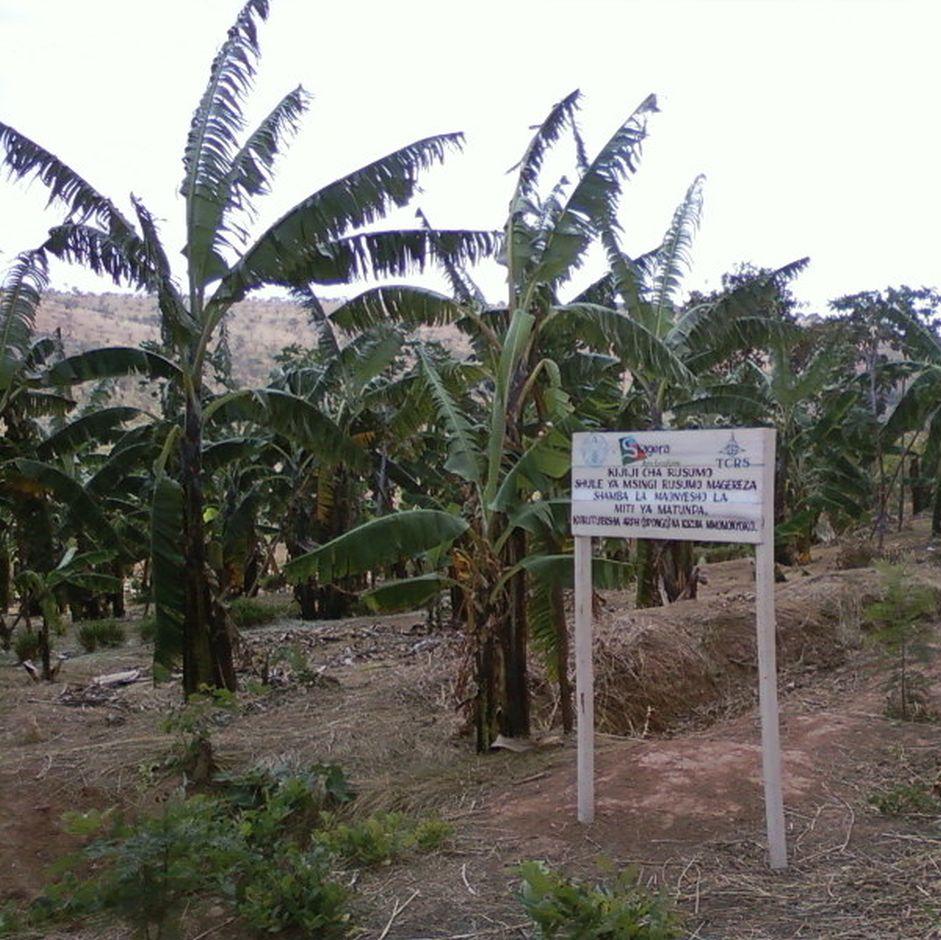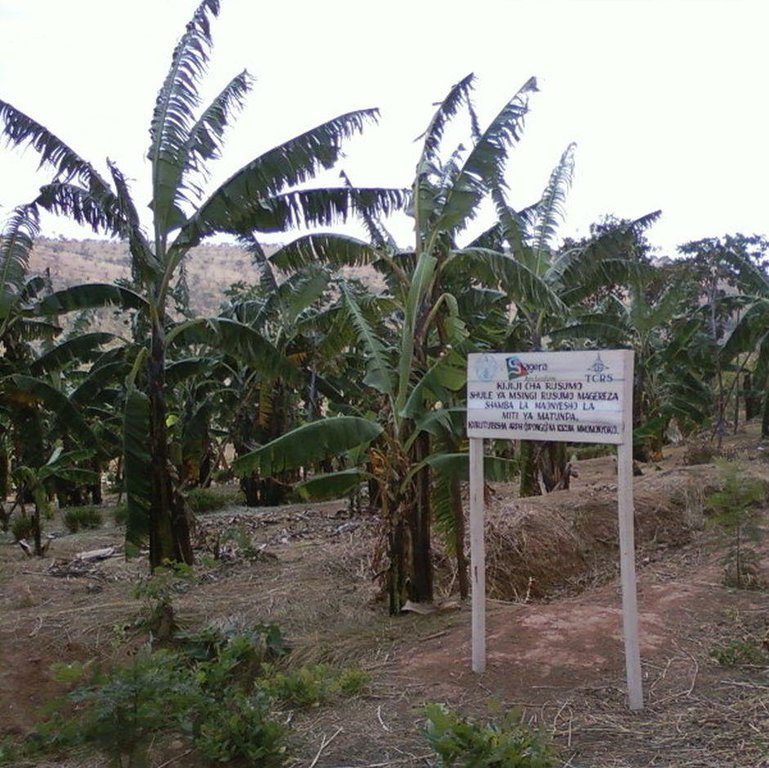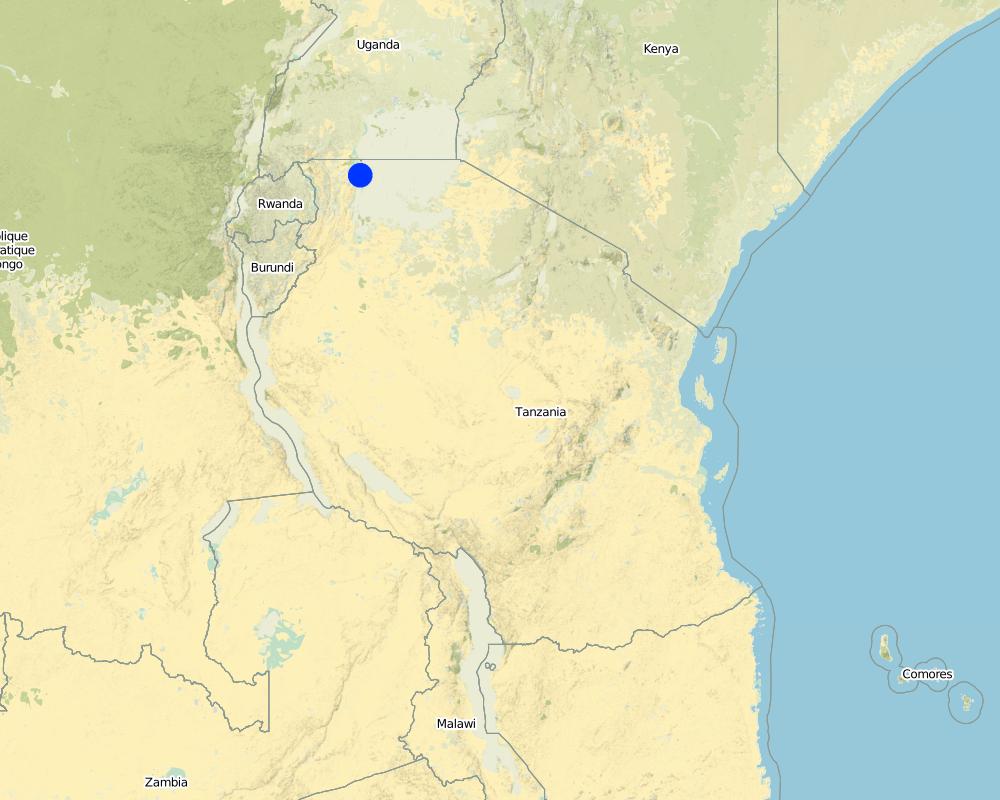Slope cross barier in banana combined with common agronomical measures production [ប្រទេសតង់សានី]
- ការបង្កើត៖
- បច្ចុប្បន្នភាព
- អ្នកចងក្រង៖ Godfrey Baraba
- អ្នកកែសម្រួល៖ –
- អ្នកត្រួតពិនិត្យ David Streiff
Makinganga maji mchanganyiko
technologies_1216 - ប្រទេសតង់សានី
ពិនិត្យមើលគ្រប់ផ្នែក
ពង្រីកមើលទាំងអស់ បង្រួមទាំងអស់1. ព័ត៌មានទូទៅ
1.2 ព័ត៌មានលម្អិតពីបុគ្គលសំខាន់ៗ និងស្ថាប័នដែលចូលរួមក្នុងការវាយតម្លៃ និងចងក្រងឯកសារនៃបច្ចេកទេស
អ្នកជំនាញឯកទេស SLM:
Kakilla Samuel
TCRS-Ngara
ប្រទេសតង់សានី
អ្នកជំនាញឯកទេស SLM:
Chitege Daudi
Magereza Rusoma Primary School
ប្រទេសតង់សានី
អ្នកជំនាញឯកទេស SLM:
Masikundima Iddi
Ngara District Council
ប្រទេសតង់សានី
អ្នកជំនាញឯកទេស SLM:
ឈ្មោះគម្រោងដែលបានចងក្រងឯកសារ/ វាយតម្លៃលើបច្ចេកទេស (បើទាក់ទង)
The Transboundary Agro-ecosystem Management Project for the Kagera River Basin (GEF-FAO / Kagera TAMP )ឈ្មោះអង្គភាពមួយ (ច្រើន) ដែលបានចងក្រងឯកសារ/ វាយតម្លៃបច្ចេកទេស (បើទាក់ទង)
Bukoba district council (Bukoba district council) - ប្រទេសតង់សានីឈ្មោះអង្គភាពមួយ (ច្រើន) ដែលបានចងក្រងឯកសារ/ វាយតម្លៃបច្ចេកទេស (បើទាក់ទង)
Ngara District Council (Ngara District Council) - ប្រទេសតង់សានីឈ្មោះអង្គភាពមួយ (ច្រើន) ដែលបានចងក្រងឯកសារ/ វាយតម្លៃបច្ចេកទេស (បើទាក់ទង)
Missenyi District Council (Missenyi District Council) - ប្រទេសតង់សានី1.3 លក្ខខណ្ឌទាក់ទងទៅនឹងការប្រើប្រាស់ទិន្នន័យដែលបានចងក្រងតាមរយៈ វ៉ូខេត
តើពេលណាដែលទិន្នន័យបានចងក្រង (នៅទីវាល)?
07/08/2014
អ្នកចងក្រង និង(បុគ្គលសំខាន់ៗ)យល់ព្រមទទួលយកនូវលក្ខខណ្ឌនានាទាក់ទងទៅនឹងការប្រើប្រាស់ទិន្នន័យដែលបានចងក្រងតាមរយៈវ៉ូខេត:
បាទ/ចា៎
1.4 សេចក្តីប្រកាសស្តីពីចីរភាពនៃការពណ៌នាពីបច្ចេកទេស
តើបច្ចេកទេសដែលបានពណ៌នានេះមានបញ្ហាដែលផ្តោតលើការធ្លាក់ចុះគុណភាពដី, បើដូច្នេះវាមិនអាចត្រូវបានប្រកាសថាជាបច្ចេកទេសនៃការគ្រប់គ្រងប្រកបដោយចីរភាពទេ?
ទេ
2. ការពណ៌នាពីបច្ចេកទេស SLM
2.1 ការពណ៌នាដោយសង្ខេបពីបច្ចេកទេស
និយមន័យបច្ចេកទេស:
Is the embanked soils on the lower side of the furrow, lemon grass and vetiver grass strips along the contour lines combined with Farm yard manures and grass mulch application in banana production.
2.2 ការពណ៌នាលម្អិតពីបច្ចេកទេស
ការពណ៌នា:
The slope cross barrier technology in banana production is a 2m deep by 0.6 wide furrow at the less slope combined with lemon grass, vetiver grass contour strips at the greater slopes.. The lemon grasses and vertiver grass are planted in single row spaced 0.3m plant to plant. The distance between strips is about 18m at the slope category of 2%. The technology is applied on the cropland in the tropics, sub humid, dissected plain to flood plains, sandy clay loam over sand clay and deep to moderate deep soils. The land is cultivated manually using hand hoes in a mixed production system. The land ownership is communal and individual not titled. The establishment procedures includes planting of banana suckers, lemon grass, vetiver grass, fruit trees, construction of fanya chini and planting gravelia spps along the boundaries. The maintenance procedures require application of FYM at the rate of 24-36kg per plant. Grass mulch is spread across the slope at the thickness of 0.15m. The average establishment costs is US$ 3,531.42 per hectare while maintenance costs on average is US$ 351.77 per hectare. The technology was introduced fifteen months past ( March 2013) using Demonstration plots methodology. Common agronomic measures such as using improved banana suckers and banana weevils trapping can add extra effectiveness to the main technology.
Purpose of the Technology: The general purpose of the technology is to reduce soil erosion, reduce soil moisture stress and increase soil nutrient cycling and soil organic matters.
Establishment / maintenance activities and inputs: The establishment activities includes first, clearing and cultivation of land in May done manually using machete and hand hoes. Second, harrowing in May done manually using fork handhoes. Third is identification and demarcation of contour lines doneusing A-frame. Fourth is spacing and digging of holes for banana and fruit trees done manually done. Fifth is planting of banana suckers and fruit trees done manually. Sixth is planting of vertiver and lemon grasses along the demarcated contour lines done manually, seventh is digging the farrow and excavating soils to be placed at the lower side of the furrow done manually. The maintenance activities include; first, weeding the entire field using hands done in twice April and October. Second is manure application using plastic buskets done. Third is spreading grass mulch done manually, fourth is desuckering using chisel hand hoes done twice in April and October. Fourth is detrushing using machete and local made tools (rwabyo) done twice (May and January). Last but not least is harvesting of banana, lemon grass and fruits done on market demand.
Natural / human environment: The land ownership is communal and individual not entitled while the water use right is open access. The natural environments are 1184mm of rainfall.The technology is tolerant to drought and seasonal rainfall decrease. Soil fertility is low to moderate. Top soil organic matter is medium, Soil drainage is medium. Soil water storage capacity is medium.
2.3 រូបភាពនៃបច្ចេកទេស
2.5 ប្រទេស/តំបន់/ទីតាំងកន្លែង ដែលបច្ចេកទេសត្រូវបានអនុវត្ត និងបានគ្រប់ដណ្តប់ដោយការវាយតម្លៃនេះ
ប្រទេស:
ប្រទេសតង់សានី
តំបន់/រដ្ឋ/ខេត្ត:
Tanzania
បញ្ជាក់បន្ថែមពីលក្ខណៈនៃទីតាំង:
Bukoba
Map
×2.6 កាលបរិច្ឆេទនៃការអនុវត្ត
ប្រសិនបើមិនច្បាស់ឆ្នាំ សូមបញ្ជាក់កាលបរិច្ឆេទដែលប្រហាក់ប្រហែល:
- តិចជាង 10ឆ្នាំមុន (ថ្មី)
2.7 ការណែនាំពីបច្ចេកទេស
សូមបញ្ជាក់តើបច្ចេកទេសត្រូវបានណែនាំឱ្យអនុវត្តដោយរបៀបណា:
- តាមរយៈគម្រោង / អន្តរាគមន៍ពីខាងក្រៅ
មតិយោបល់ (ប្រភេទនៃគម្រោង ។ល។):
In February 2013 TAMP -Kagera, Tanzania introduced the technology through demonstration sites for cross slope beerier technology at Magereza Rusumo Primary School.
3. ចំណាត់ថ្នាក់នៃបច្ចេកទេស SLM
3.1 គោលបំណងចម្បង (១ ឬច្រើន) នៃបច្ចេកទេសនេះ
- កាត់បន្ថយ, បង្ការ, ស្តារឡើងវិញនូវការធ្លាក់ចុះគុណភាពដី
3.2 ប្រភេទដីប្រើប្រាស់មួយប្រភេទ (ច្រើនប្រភេទ) ដែលបានអនុវត្តបច្ចេកទេស

ដីដាំដំណាំ
- ដំណាំប្រចាំឆ្នាំ
- ដំណាំរយៈពេលវែង (មិនមែនឈើ)
- ប្រភេទដើមឈើធំៗ និងដើមឈើតូចៗ
ដំណាំចម្បង (ដំណាំកសិ-ឧស្សាហកម្ម និងដំណាំស្បៀង) :
major cash crop: Sorghum and avocado
major food crop: Maize and banana
មតិយោបល់:
Major land use problems (compiler’s opinion): The major land use problems were soil erosion, moistture stress, declining soil nutrients and organic matters.
Major land use problems (land users’ perception): The major land use problems were reduced soil fertility.
Future (final) land use (after implementation of SLM Technology): Cropland: Cp: Perennial (non-woody) cropping
3.3 ព័ត៌មានបន្ថែមអំពីអ្នកប្រើប្រាស់ដី
ការផ្គត់ផ្គង់ទឹកនៅកន្លែងអនុវត្តបច្ចេកទេស:
- ទឹកភ្លៀង
ចំនួនសារដែលដាំដំណាំក្នុងមួយឆ្នាំ:
- 2
សូមបញ្ជាក់:
Longest growing period in days: 90; Longest growing period from month to month: March to May; Second longest growing period in days: 60;Second longest growing period from month to month: November to December
3.4 ក្រុម SLM ដែលបច្ចេកទេសស្ថិតនៅក្នុង
- ធ្វើឱ្យប្រសើរឡើងគម្របដី/ ដំណាំគម្របដី
- វិធានការអនុវត្តកាត់ទទឹងទីជម្រាល
3.5 ការសាយភាយនៃបច្ចេកទេស
បញ្ជាក់ពីការសាយភាយនៃបច្ចេកទេស:
- ត្រូវបានផ្សព្វផ្សាយត្រឹមតំបន់មួយ
ប្រសិនបើបច្ចេកទេសត្រូវបានសាយភាយពាសពេញតំបន់ណាមួយ សូមកំណត់ទំហំផ្ទៃដីអនុវត្តន៍:
- < 0.1 គម2 (10 ហិកតា)
មតិយោបល់:
A demonstration plot for pupils self-reliance education studies established a plot measured 2 acres where the technology is applied.
3.6 វិធានការ SLM ដែលបញ្ចូលនូវបច្ចេកទេស

វិធានការក្សេត្រសាស្ត្រ
- A1: ដំណាំ/គម្របដី
- A2: សារធាតុសរីរាង្គ/ជីជាតិដី

វិធានការរុក្ខជាតិ
- V2: ស្មៅនិងរុក្ខជាតិៗដែលដុះមានអាយុមិនលើសពី 2ឆ្នាំ

វិធានការរចនាស័ម្ពន្ធ
- S2: ភ្លឺ ច្រាំង
- S4: កម្រិតភ្លឺ រណ្តៅ
មតិយោបល់:
Type of agronomic measures: mulching, temporary trashlines, manure / compost / residues, pits
Type of vegetative measures: aligned: -contour, aligned: -along boundary, aligned: -linear, scattered / dispersed, in blocks
3.7 កំណត់ប្រភេទនៃការធ្លាក់ចុះគុណភាពដីសំខាន់ៗដែលបច្ចេកទេសនេះបានដោះស្រាយ

ការហូរច្រោះដីដោយសារទឹក
- Wt: ការបាត់ដីស្រទាប់លើដោយការហូរច្រោះ

ការធ្លាក់ចុះសារធាតុគីមីក្នុងដី
- Cn: ការថយចុះជីជាតិ និងកាត់បន្ថយបរិមាណសារធាតុសរីរាង្គ (មិនកើតឡើងដោយការហូរច្រោះទេ)

ការធ្លាក់ចុះជីវសាស្ត្រនៃដី
- Bl: ការបាត់បង់មីក្រូ និងម៉ាក្រូសរីរាង្គរបស់ដី
មតិយោបល់:
Main causes of degradation: soil management (Cultivation along the slope), change of seasonal rainfall (decreased rainfall intensity.), droughts (Increased length of dry spell.), population pressure (Increased population density had forced to cultivate slope land to meet the social economical requirements.), poverty / wealth (Land users cant afford to invest in land concervations.), education, access to knowledge and support services (Inadequate staffing limits effective support services for land users to access land concervation knowledge.), governance / institutional (Environment policy implimentation is weak at lower levels.)
3.8 ការពារ កាត់បន្ថយ ឬស្តារឡើងវិញនៃការធ្លាក់ចុះគុណភាពដី
បញ្ជាក់ពីគោលដៅរបស់បច្ចេកទេស ដែលផ្តោតទៅការធ្លាក់ចុះគុណភាពដី:
- ការការពារការធ្លាក់ចុះគុណភាពដី
- ការកាត់បន្ថយការធ្លាក់ចុះគុណភាពដី
4. បច្ចេកទេសជាក់លាក់ សកម្មភាពអនុវត្ត ធាតុចូល និងថ្លៃដើម
4.2 លក្ខណៈពិសេសនៃបច្ចេកទេស/ ពណ៌នាពីគំនូរបច្ចេកទេស
Technical knowledge required for field staff / advisors: low (Basic priciples are taught at colleges.)
Technical knowledge required for land users: moderate (The new technology should be taught first for a better innovation and adoption processes.)
Main technical functions: control of raindrop splash, control of dispersed runoff: retain / trap, control of dispersed runoff: impede / retard, increase in organic matter, increase of infiltration, increase / maintain water stored in soil, increase of biomass (quantity)
Secondary technical functions: stabilisation of soil (eg by tree roots against land slides), increase in nutrient availability (supply, recycling,…), reduction in wind speed
Mulching
Material/ species: Panic grasses
Quantity/ density: 1500
Remarks: 0.15m thickness across the slope.
Temporary trashlines
Material/ species: banana dry leaves abd old pseudostems.
Manure / compost / residues
Material/ species: Trushlines
Quantity/ density: 7.5t0nes
Remarks: A 2m X2mX3m pit is dug at the centre of foor banana stools and pilled.
Pits
Material/ species: .
Remarks: a 0.3m depth is left un covered with soil below the soil surface level
Aligned: -contour
Vegetative material: G : grass
Number of plants per (ha): 700
Width within rows / strips / blocks (m): 0.6
Aligned: -along boundary
Vegetative material: T : trees / shrubs
Number of plants per (ha): 70
Width within rows / strips / blocks (m): 6
Aligned: -linear
Vegetative material: C : perennial crops
Number of plants per (ha): 715
Spacing between rows / strips / blocks (m): 4
Width within rows / strips / blocks (m): 3.5
Scattered / dispersed
Vegetative material: T : trees / shrubs
Number of plants per (ha): 625
Spacing between rows / strips / blocks (m): 4
Width within rows / strips / blocks (m): 4
In blocks
Vegetative material: F : fruit trees / shrubs
Width within rows / strips / blocks (m): 3
Trees/ shrubs species: gravelia spps
Fruit trees / shrubs species: Mango, Pawpaw and oranges
Perennial crops species: Banana
Grass species: lemon grass and vetiver
Retention/infiltration ditch/pit, sediment/sand trap
Depth of ditches/pits/dams (m): 0.2
Width of ditches/pits/dams (m): 0.2
Length of ditches/pits/dams (m): 0.2
Structural measure: Fanya chini
Vertical interval between structures (m): E
Depth of ditches/pits/dams (m): 1.5
Width of ditches/pits/dams (m): 0.6
Length of ditches/pits/dams (m): 105
Height of bunds/banks/others (m): 0.6
Width of bunds/banks/others (m): 0.9
Length of bunds/banks/others (m): 105
4.3 ព័ត៌មានទូទៅដែលពាក់ព័ន្ធនឹងការគណនាធាតុចូល និងថ្លៃដើម
កំណត់រូបិយប័ណ្ណសម្រាប់ថ្លៃដើម:
- ដុល្លារអាមេរិក
កំណត់ថ្លៃឈ្នួលជាមធ្យមនៃការជួលកម្លាំងពលកម្មក្នុងមួយថ្ងៃ:
1.88
4.4 សកម្មភាពបង្កើត
| សកម្មភាព | ប្រភេទវិធានការ | ពេលវេលា | |
|---|---|---|---|
| 1. | Ploughoing | សារពើរុក្ខជាតិ | May |
| 2. | Harrowing | សារពើរុក្ខជាតិ | may |
| 3. | Digging holes | សារពើរុក្ខជាតិ | |
| 4. | Demarcating contour lines | សារពើរុក្ខជាតិ | |
| 5. | Digging holes for planting banana suckers | សារពើរុក្ខជាតិ | |
| 6. | Demacarting banana spacings. | សារពើរុក្ខជាតិ | |
| 7. | Mixing FYM | សារពើរុក្ខជាតិ | |
| 8. | Plating banana suckers | សារពើរុក្ខជាតិ | |
| 9. | Planting vetiver grass and lemon grass. | សារពើរុក្ខជាតិ | May |
| 10. | Planting mango, pawpaw, orange and gravelia | សារពើរុក្ខជាតិ | January |
| 11. | Demarcation of contour line using F-frame. | រចនាសម្ព័ន្ធ | March |
| 12. | Digging the furrow and excavating soils. | រចនាសម្ព័ន្ធ | May |
4.5 ថ្លៃដើម និងធាតុចូលដែលត្រូវការសម្រាប់ការបង្កើតបច្ចេកទេស
| បញ្ជាក់ពីធាតុចូល | ឯកតា | បរិមាណ | ថ្លៃដើមក្នុងមួយឯកតា | ថ្លៃធាតុចូលសរុប | % នៃថ្លៃដើមដែលចំណាយដោយអ្នកប្រើប្រាស់ដី | |
|---|---|---|---|---|---|---|
| កម្លាំងពលកម្ម | Labour | ha | 1,0 | 541,18 | 541,18 | |
| សម្ភារៈ | Tools | ha | 1,0 | 134,31 | 134,31 | |
| សម្ភារៈដាំដុះ | Seedling | ha | 1,0 | 2032,4 | 2032,4 | |
| ជី និងសារធាតុពុល | Compost / manure | ha | 1,0 | 823,53 | 823,53 | |
| ថ្លៃដើមសរុបក្នុងការបង្កើតបច្ចេកទេស | 3531,42 | |||||
មតិយោបល់:
Duration of establishment phase: 15 month(s)
4.6 សកម្មភាពថែទាំ
| សកម្មភាព | ប្រភេទវិធានការ | ពេលវេលា/ ភាពញឹកញាប់ | |
|---|---|---|---|
| 1. | Weeding | ក្សេត្រសាស្ត្រ | april |
| 2. | Desuckering and detrushing | ក្សេត្រសាស្ត្រ | January and may |
| 3. | Mulch grass application | ក្សេត្រសាស្ត្រ | May |
| 4. | Pr-oping (anchor poles placement) | ក្សេត្រសាស្ត្រ | routeenly |
| 5. | Harvesting banana fruits. | ក្សេត្រសាស្ត្រ | routeenly |
| 6. | Planting ricinus communis | ក្សេត្រសាស្ត្រ | February |
| 7. | Trees Pruning | សារពើរុក្ខជាតិ | |
| 8. | Harvesting fruits | សារពើរុក្ខជាតិ | |
| 9. | To remove soil sediments from the furrow and place the in the space between. | រចនាសម្ព័ន្ធ | May and January |
| 10. | To cvlear fire-break along the bounderies | រចនាសម្ព័ន្ធ | May |
4.7 កំណត់ថ្លៃដើមសម្រាប់ការថែទាំ/ សកម្មភាពរបស់បច្ចេកទេស (ក្នុងរយៈពេលមួយឆ្នាំ)
| បញ្ជាក់ពីធាតុចូល | ឯកតា | បរិមាណ | ថ្លៃដើមក្នុងមួយឯកតា | ថ្លៃធាតុចូលសរុប | % នៃថ្លៃដើមដែលចំណាយដោយអ្នកប្រើប្រាស់ដី | |
|---|---|---|---|---|---|---|
| កម្លាំងពលកម្ម | Labour | ha | 1,0 | 153,73 | 153,73 | 100,0 |
| សម្ភារៈដាំដុះ | Seeds | ha | 1,0 | 1,96 | 1,96 | 100,0 |
| ជី និងសារធាតុពុល | Grass mulch | ha | 1,0 | 196,08 | 196,08 | 100,0 |
| ថ្លៃដើមសរុបសម្រាប់ការថែទាំដំណាំតាមបច្ចេកទេស | 351,77 | |||||
5. លក្ខណៈបរិស្ថានធម្មជាតិ និងមនុស្ស
5.1 អាកាសធាតុ
បរិមាណទឹកភ្លៀងប្រចាំឆ្នាំ
- < 250 មម
- 251-500 មម
- 501-750 មម
- 751-1,000 មម
- 1,001-1,500 មម
- 1,501-2,000 មម
- 2,001-3,000 មម
- 3,001-4,000 មម
- > 4,000 មម
លក្ខណៈពិសេស/ មតិយោបល់លើរដូវភ្លៀង:
Highet precipitation March to May and second precipitation November to December.
តំបន់កសិអាកាសធាតុ
- មានភ្លៀងមធ្យម
Thermal climate class: tropics. All months is above 18°C
LGP 60dys to 90dys
5.2 សណ្ឋានដី
ជម្រាលជាមធ្យម:
- រាបស្មើ (0-2%)
- ជម្រាលតិចតួច (3-5%)
- មធ្យម (6-10%)
- ជម្រាលខ្ពស់បន្តិច (11-15%)
- ទីទួល (16-30%)
- ទីទួលចោត (31-60%)
- ទីទួលចោតខ្លាំង (>60%)
ទម្រង់ដី:
- ខ្ពង់រាប
- កំពូលភ្នំ
- ជម្រាលភ្នំ
- ជម្រាលទួល
- ជម្រាលជើងភ្នំ
- បាតជ្រលងភ្នំ
តំបន់តាមរយៈកម្ពស់ :
- 0-100 ម
- 101-500 ម
- 501-1,000 ម
- 1,001-1,500 ម
- 1,501-2,000 ម
- 2,001-2,500 ម
- 2,501-3,000 ម
- 3,001-4,000 ម
- > 4,000 ម
បញ្ជាក់ថាតើបច្ចេកទេសនេះត្រូវបានអនុវត្តន៍នៅក្នុង:
- មិនពាក់ព័ន្ធទាំងអស់
មតិយោបល់ និងបញ្ចាក់បន្ថែមអំពីសណ្ឋានដី :
Slopes on average: 3 adption land users are found in the flat areas and a 1.5 acre is demonstration plot site where thye adoption plots found elsewhere.
5.3 ដី
ជម្រៅដីជាមធ្យម:
- រាក់ខ្លាំង (0-20 សម)
- រាក់ (21-50 សម)
- មធ្យម (51-80 សម)
- ជ្រៅ (81-120 សម)
- ជ្រៅខ្លាំង (> 120 សម)
វាយនភាពដី (ស្រទាប់លើ):
- មធ្យម (ល្បាយ, ល្បាប់)
សារធាតុសរីរាង្គនៅស្រទាប់ដីខាងលើ:
- មធ្យម (1-3%)
បើអាចសូមភ្ជាប់ការពណ៌នាពីដីឱ្យបានច្បាស់ ឬព័ត៌មានដែលអាចទទួលបាន ឧ. ប្រភេទដី, pH ដី/ ជាតិអាស៊ីត, សមត្ថភាពផ្លាស់ប្តូរកាចុង, វត្តមាននីត្រូសែន, ភាពប្រៃ ។ល។:
Soil depth on average: Redish brown/dark brown sandy clay loam over sandy clay
Soil fertilityis low and DP Low to moderate
Soil drainage / infiltration is medium and DP well drained
Soil water storage capacity is medium
5.4 ទឹកដែលអាចទាញមកប្រើប្រាស់បាន និងគុណភាពទឹក
នីវ៉ូទឹកក្រោមដី:
> 50 ម
ទឹកលើដីដែលអាចទាញយកប្រើប្រាស់បាន:
កម្រិតមធ្យម
គុណភាពទឹក (មិនបានធ្វើប្រត្តិកម្ម):
ទឹកពិសារដែលគ្មានគុណភាព (តម្រូវឱ្យមានការសំអាត)
មតិយោបល់ និងលក្ខណៈពិសេសផ្សេងៗទៀតលើគុណភាព និងបរិមាណទឹក :
Availability of surface water: Bordering Kagera river.
5.5 ជីវៈចម្រុះ
ភាពសម្បូរបែបនៃប្រភេទ:
- កម្រិតមធ្យម
មតិយោបល់ និងលក្ខណៈពិសេសផ្សេងទៀតលើជីវចម្រុះ:
Earthworms, black ants etc.
5.6 លក្ខណៈនៃអ្នកប្រើប្រាស់ដីដែលអនុវត្តបច្ចេកទេស
ទីផ្សារនៃប្រព័ន្ធផលិតកម្ម:
- ពាក់កណ្តាលពាណិជ្ជកម្ម (ផ្គត់ផ្គង់ខ្លួនឯង/ ពាណិជ្ជកម្ម
- ពាណិជ្ជកម្ម/ ទីផ្សារ
ឯកជន ឬក្រុម:
- ជាក្រុម/ សហគមន៍
កម្រិតប្រើប្រាស់គ្រឿងយន្ត:
- ប្រើកម្លាំងពលកម្ម
យេនឌ័រ:
- ស្ត្រី
- បុរស
សូមបញ្ជាក់ពីលក្ខណៈពាក់ព័ន្ធផ្សេងទៀតអំពីអ្នកប្រើប្រាស់ដី:
Land users applying the Technology are mainly common / average land users
Market orientation of production system: Fruits intededed for sale and banana are dual purposes.
Level of mechanization: Hand hoes are used.
5.7 ទំហំផ្ទៃដីជាមធ្យមនៃដីផ្ទាល់ខ្លួន ឬជួលគេដែលបានអនុវត្តបច្ចេកទេស
- < 0.5 ហិកតា
- 0.5-1 ហិកតា
- 1-2 ហិកតា
- 2-5 ហិកតា
- 5-15 ហិកតា
- 15-50 ហិកតា
- 50-100 ហិកតា
- 100-500 ហិកតា
- 500-1,000 ហិកតា
- 1,000-10,000 ហិកតា
- > 10,000 ហិកតា
តើផ្ទៃដីនេះចាត់ទុកជាទំហំកម្រិតណាដែរ ខ្នាតតូច មធ្យម ឬខ្នាតធំ (ធៀបនឹងបរិបទតំបន់)?
- ខ្នាតតូច
5.8 ភាពជាម្ចាស់ដី កម្មសិទ្ធប្រើប្រាស់ដី និងកម្មសិទ្ធប្រើប្រាស់ទឹក
ភាពជាម្ចាស់ដី:
- ឯកជន មិនមានកម្មសិទ្ធ
- Institutions
កម្មសិទ្ធិប្រើប្រាស់ដី:
- ឯកជន
- village goverment
កម្មសិទ្ធប្រើប្រាស់ទឹក:
- អាស្រ័យផលសេរី (មិនមានការកំណត់)
- village goverment
5.9 ការប្រើប្រាស់សេវាកម្ម និងហេដ្ឋារចនាសម្ព័ន្ធ
សុខភាព:
- មិនល្អ
- មធ្យម
- ល្អ
ការអប់រំ:
- មិនល្អ
- មធ្យម
- ល្អ
ជំនួយបច្ចេកទេស:
- មិនល្អ
- មធ្យម
- ល្អ
ការងារ (ឧ. ការងារក្រៅកសិដ្ឋាន):
- មិនល្អ
- មធ្យម
- ល្អ
ទីផ្សារ:
- មិនល្អ
- មធ្យម
- ល្អ
ថាមពល:
- មិនល្អ
- មធ្យម
- ល្អ
ផ្លូវ និងការដឹកជញ្ជូន:
- មិនល្អ
- មធ្យម
- ល្អ
សេវាកម្មហិរញ្ញវត្ថុ:
- មិនល្អ
- មធ្យម
- ល្អ
6. ផលប៉ះពាល់ និងការសន្និដ្ឋាន
6.1 ផលប៉ះពាល់ក្នុងបរិវេណអនុវត្តបច្ចេកទេសដែលកើតមាន
ផលប៉ះពាល់លើសេដ្ឋកិច្ចសង្គម
ផលិតផល
ផលិតកម្មដំណាំ
គុណភាពមុន SLM:
0
គុណភាពក្រោយ SLM:
5
មតិយោបល់/ ការបញ្ជាក់:
Banana first harvest
ហានិភ័យនៃភាពបរាជ័យរបស់ផលិតកម្ម
មតិយោបល់/ ការបញ្ជាក់:
Mulch reduced moisture stress
ចំណូល និងថ្លៃដើម
ការចំណាយលើធាតុចូលកសិកម្ម
មតិយោបល់/ ការបញ្ជាក់:
Improved seeds and seedlings, FYM & grass mulch
ចំណូលក្នុងកសិដ្ឋាន
ភាពសម្បូរបែបប្រភពប្រាក់ចំណូល
មតិយោបល់/ ការបញ្ជាក់:
Orchad as comlimentary enterprises
បន្ទុកការងារ
មតិយោបល់/ ការបញ្ជាក់:
FYM and mulch applications demanded extra labour
ផលប៉ះពាល់ទៅលើវប្បធម៌សង្គម
សន្តិសុខស្បៀង/ ភាពគ្រប់គ្រាន់ខ្លួនឯង
មតិយោបល់/ ការបញ្ជាក់:
Conseved land ensured soil improvement to ensure food availability, accessility and utilizations
ចំណេះដឹង SLM / ការធ្លាក់ចុះគុណភាពដី
មតិយោបល់/ ការបញ្ជាក់:
AESA conducted during FFS
ស្ថានភាពក្រុមដែលមានបញ្ហាក្នុងសង្គម និងសេដ្ឋកិច្ច
មតិយោបល់/ ការបញ្ជាក់:
Equal chances for different gender considered in FFS formulation
livelihood and human well-being
មតិយោបល់/ ការបញ្ជាក់:
The effective technology duration is too short to obeserve impacts, but we can say that, there is hope for the technology to contribute highly on livelihod and human wellbeing
ផលប៉ះពាល់ទៅលើអេកូឡូស៊ី
វដ្តទឹក/លំហូរ
លំហូរទឹកលើផ្ទៃដី
មតិយោបល់/ ការបញ្ជាក់:
Mulching
រំហួត
មតិយោបល់/ ការបញ្ជាក់:
Mulching
ដី
សំណើមដី
មតិយោបល់/ ការបញ្ជាក់:
Pitt and furrows
គម្របដី
មតិយោបល់/ ការបញ្ជាក់:
Mulching
ការបាត់បង់ដី
មតិយោបល់/ ការបញ្ជាក់:
Contours
សារធាតុសរីរាង្គដី/ការបូនក្រោមដី
មតិយោបល់/ ការបញ្ជាក់:
FYM
ជីវចម្រុះ៖ ដំណាំ, សត្វ
ជីវម៉ាស/ កាបូនលើដី
មតិយោបល់/ ការបញ្ជាក់:
Trushlines
6.2 ផលប៉ះពាល់ក្រៅបរិវេណអនុវត្តបច្ចេកទេសដែលកើតមាន
ខូចខាតដល់ស្រែអ្នកជិតខាង
មតិយោបល់/ ការបញ្ជាក់:
Ditches traped running water down the slope
ខូចខាតដល់ហេដ្ឋារចនាសម្ព័ន្ធសាធារណៈ/ឯកជន
មតិយោបល់/ ការបញ្ជាក់:
Farrow and bunds along contour lines minimized water run off in the area
6.3 ភាពប្រឈម និងភាពរួសនៃបច្ចេកទេសទៅនឹងការប្រែប្រួលអាកាសធាតុ និងគ្រោះអាកាសធាតុ/ គ្រោះមហន្តរាយ (ដែលដឹងដោយអ្នកប្រើប្រាស់ដី)
គ្រោះអាកាសធាតុ (មហន្តរាយ)
គ្រោះមហន្តរាយធម្មជាតិ
| លក្ខណៈឆ្លើយតបនៃបច្ចេកទេសទៅនឹងការប្រែប្រួលអាកាសធាតុ | |
|---|---|
| ព្យុះភ្លៀងតាមតំបន់ | មិនល្អ |
គ្រោះមហន្តរាយអាកាសធាតុ
| លក្ខណៈឆ្លើយតបនៃបច្ចេកទេសទៅនឹងការប្រែប្រួលអាកាសធាតុ | |
|---|---|
| រាំងស្ងួត | ល្អ |
មតិយោបល់:
The technology can be modified to become more tolerant by meter drain construction from the contour furrow into drainage ditches to collect excess water during heavy rainfall events. This excess water should be used for small scale irrigation.
6.4 ការវិភាគថ្លៃដើម និងអត្ថប្រយោជន៍
តើផលចំណេញ និងថ្លៃដើមត្រូវបានប្រៀបធៀបគ្នាយ៉ាងដូចម្តេច (ទស្សនៈរបស់អ្នកប្រើប្រាស់ដី)?
រយៈពេលខ្លី:
អវិជ្ជមាន
រយៈពេលវែង:
វិជ្ជមានខ្លាំង
តើផលចំណេញ និងការថែទាំ/ ជួសជុលត្រូវបានប្រៀបធៀបគ្នាយ៉ាងដូចម្តេច (ទស្សនៈរបស់អ្នកប្រើប្រាស់ដី)?
រយៈពេលខ្លី:
វិជ្ជមានតិចតួច
រយៈពេលវែង:
ប៉ះពាល់តិចតួចបំផុត
6.5 ការទទួលយកបច្ចេកទេស
- ច្រើនជាង 50%
បើអាច សូមបញ្ជាក់ពីបរិមាណ (ចំនួនគ្រួសារ និង/ ឬតំបន់គ្របដណ្តប់):
8 households
ក្នុងចំណោមគ្រួសារទាំងអស់ដែលអនុវត្តបច្ចេកទេស តើមានប៉ុន្មានគ្រួសារដែលចង់ធ្វើដោយខ្លួនឯង ដោយមិនទទួលបានសម្ភារៈលើកទឹកចិត្ត/ប្រាក់ឧបត្ថម្ភ?:
- 10-50%
មតិយោបល់:
4 land user families have adopted the Technology with external material support
Comments on acceptance with external material support: Only the primary school received external materials to establish a 1.5 acre demonstration plots.
4 land user families have adopted the Technology without any external material support
Comments on spontaneous adoption: Three teachers applied the technology at their own lands bearing their full cost of implimentation.
There is a strong trend towards spontaneous adoption of the Technology
Comments on adoption trend: A 75% adption rate within a less than two years effective duration implies a strong adoption trend.
6.7 ភាពខ្លាំង/ គុណសម្បត្តិ/ ឱកាសនៃបច្ចេកទេស
| ភាពខ្លាំង/ គុណសម្បត្តិ/ ឱកាស ទស្សនៈរបស់បុគ្គលសំខាន់ៗ |
|---|
| Easy to learn and practice. |
| social economic and production very feasible at increasing return to scale. |
| Ecological benefits should maintain constant returns to scale |
6.8 ភាពខ្សោយ/ គុណវិបត្តិ/ ហានិភ័យនៃបច្ចេកទេស និងវិធីសាស្ត្រដោះស្រាយ
| ភាពខ្សោយ/ គុណវិបត្តិ/ ហានិភ័យ ទស្សនៈរបស់អ្នកចងក្រងឬបុគ្គលសំខាន់ៗ | តើបច្ចេកទេសទាំងនោះបានដោះស្រាយបញ្ហាដូចម្តេច? |
|---|---|
| Increased farm input costs. | |
| Highly extension services demand to learn new technology. | |
| Thieving attractions |
7. ឯកសារយោង និងវេបសាយ
7.1 វិធីសាស្ត្រ/ ប្រភពនៃព័ត៌មាន
- តាមការចុះទីវាល ការស្រាវជ្រាវនៅទីវាល
- ការសម្ភាសន៍ជាមួយអ្នកប្រើប្រាស់ដី
ការតភ្ជាប់ និងម៉ូឌុល
ពង្រីកមើលទាំងអស់ បង្រួមទាំងអស់ការតភ្ជាប់
គ្មានការតភ្ជាប់
ម៉ូឌុល
គ្មានម៉ូឌុល




